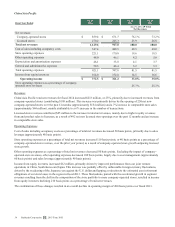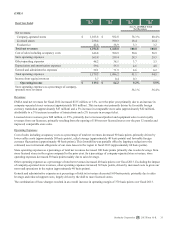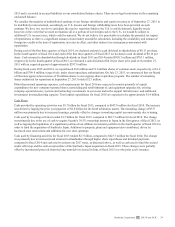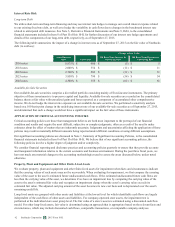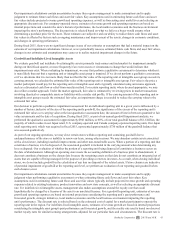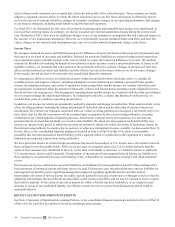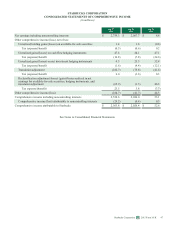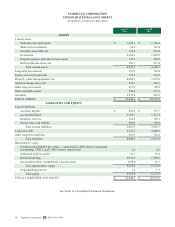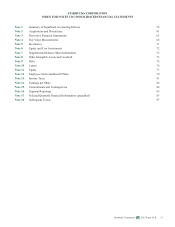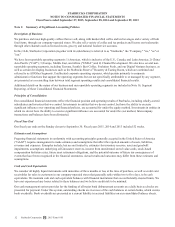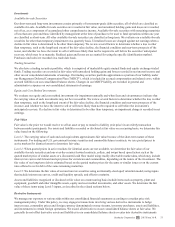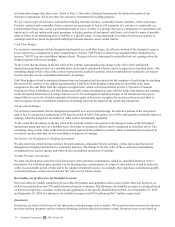Starbucks 2015 Annual Report Download - page 48
Download and view the complete annual report
Please find page 48 of the 2015 Starbucks annual report below. You can navigate through the pages in the report by either clicking on the pages listed below, or by using the keyword search tool below to find specific information within the annual report.
selected based on the estimated cost of capital that reflects the risk profile of the related business. These estimates are highly
subjective judgments and our ability to realize the future cash flows used in our fair value calculations is affected by factors
such as the success of strategic initiatives, changes in economic conditions, changes in our operating performance, and changes
in our business strategies, including retail initiatives and international expansion.
For fiscal 2015, we determined the fair value of our material reporting units and intangible asset groups were significantly in
excess of their carrying values. Accordingly, we did not recognize any material impairment charges during the current fiscal
year. During fiscal 2015, there were no significant changes in any of our estimates or assumptions that had a material impact on
the outcome of our impairment calculations. However, as we periodically reassess estimated future cash flows and asset fair
values, changes in our estimates and assumptions may cause us to realize material impairment charges in the future.
Income Taxes
We recognize deferred tax assets and liabilities based on the differences between the financial statement carrying amounts and
the respective tax bases of our assets and liabilities. Deferred tax assets and liabilities are measured using current enacted tax
rates expected to apply to taxable income in the years in which we expect the temporary differences to reverse. We routinely
evaluate the likelihood of realizing the benefit of our deferred tax assets and may record a valuation allowance if, based on all
available evidence, we determine that some portion of the tax benefit will not be realized. Changes in tax laws and rates may
affect recorded deferred tax assets and liabilities and our effective tax rate in the future; however, we do not expect changes
from recently enacted tax laws to be material to the consolidated financial statements.
In evaluating our ability to recover our deferred tax assets within the jurisdiction from which they arise, we consider all
available positive and negative evidence, including scheduled reversals of deferred tax liabilities, projected future taxable
income, tax-planning strategies, and results of operations. In projecting future taxable income, we consider historical results
and incorporate assumptions about the amount of future state, federal, and foreign pretax operating income adjusted for items
that do not have tax consequences. Our assumptions regarding future taxable income are consistent with the plans and estimates
we are using to manage the underlying businesses. In evaluating the objective evidence that historical results provide, we
consider three years of cumulative operating income/(loss).
In addition, our income tax returns are periodically audited by domestic and foreign tax authorities. These audits include review
of our tax filing positions, including the timing and amount of deductions taken and the allocation of income between tax
jurisdictions. We evaluate our exposures associated with our various tax filing positions and recognize a tax benefit only if it is
more likely than not that the tax position will be sustained upon examination by the relevant taxing authorities, including
resolutions of any related appeals or litigation processes, based on the technical merits of our position. For uncertain tax
positions that do not meet this threshold, we record a related liability. We adjust our unrecognized tax benefit liability and
income tax expense in the period in which the uncertain tax position is effectively settled, the statute of limitations expires for
the relevant taxing authority to examine the tax position, or when new information becomes available. As discussed in Note 13,
Income Taxes, to the consolidated financial statements included in Item 8 of Part II of this 10-K, there is a reasonable
possibility that our unrecognized tax benefit liability will be adjusted within 12 months due to the expiration of a statute of
limitations and expected consent from taxing authorities.
We have generated income in certain foreign jurisdictions that has not been subject to U.S. income taxes. We intend to reinvest
these earnings for the foreseeable future. While we do not expect to repatriate cash to the U.S. to satisfy domestic liquidity
needs, if these amounts were distributed to the U.S., in the form of dividends or otherwise, we would be subject to additional
U.S. income taxes, which could be material. Determination of the amount of unrecognized deferred income tax liabilities on
these earnings is not practicable because such liability, if any, is dependent on circumstances existing if and when remittance
occurs.
Our income tax expense, deferred tax assets and liabilities, and liabilities for unrecognized tax benefits reflect management’s
best assessment of estimated current and future taxes to be paid. Deferred tax asset valuation allowances and our liabilities for
unrecognized tax benefits require significant management judgment regarding applicable statutes and their related
interpretation, the status of various income tax audits, and our particular facts and circumstances. Although we believe that the
judgments and estimates discussed herein are reasonable, actual results could differ, and we may be exposed to losses or gains
that could be material. To the extent we prevail in matters for which a liability has been established, or are required to pay
amounts in excess of our established liability, our effective income tax rate in a given financial statement period could be
materially affected.
RECENT ACCOUNTING PRONOUNCEMENTS
See Note 1, Summary of Significant Accounting Policies, to the consolidated financial statements included in Item 8 of Part II
of this 10-K for a detailed description of recent accounting pronouncements.
44 Starbucks Corporation 2015 Form 10-K


